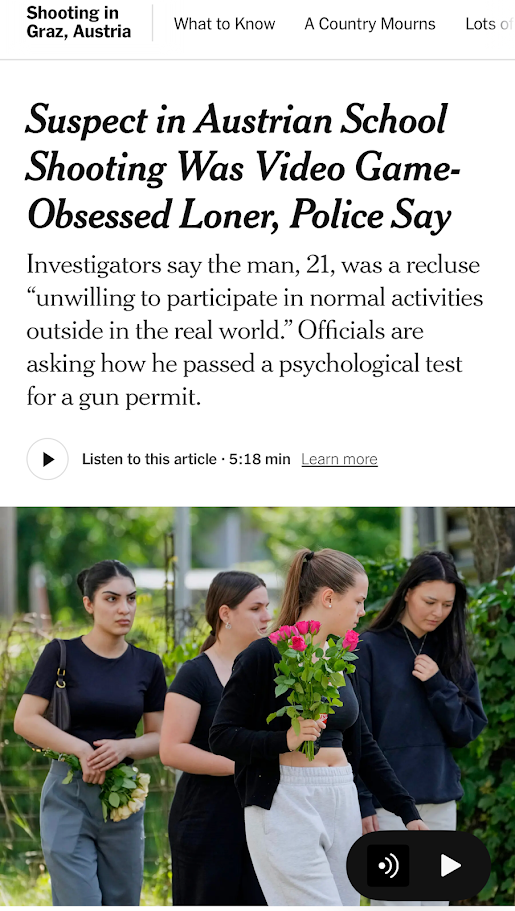Mass Shooting at Graz School Should Reopen Violent Gaming Debate
June 10th’s shooting in Graz, Austria, broke an international threshold that no one was looking forward to seeing crossed, when a 21-year old emerged from a self-initiated cyber seclusion to harshly take the lives of 10 people and himself.
Now that the awful episode has made a European school the first site of mass killing by a former student in over 15 years, could this be the right time to renew the debate on whether the shooter’s video gaming habits primed him for the devastating behavior?
Entertaining the question of violent gaming as a significant contributing factor in the outcome of a rampage school shooting has become taboo in the United States. Maybe that’s why the first NY Times headline cut in the analysis phase (generally the second day after an event) surprised when it read on the morning of June 12th:
Above: The police officer overseeing the case in Grazny said the alleged shooter was “devoted to first-person shooter games.”
In the aftermath of U.S. based shootings, there is sometimes shooter profile evidence that includes violent video gaming, but it is often marginalized over the life of the story, and its never featured in a headline summarizing a shooter situation.
Such an effort to suppress has existed for years despite acknowledgments like those of Peter Langman, Phd.— who wrote in the book Why Kids Kill (2009)— “perhaps all school shooters enjoyed violent video games.”
While many leading field experts have allowed violent video gaming into the discussion about school shootings, they just as quickly dismiss it as one not worth focusing on or proposing solutions for. Instead, the role of gaming is quickly swept off the table, either directly by industry interest groups or subtly by organizations that deny the role violent video gaming may well play in these events.
Effectively, this produces an unlevel playing field for violent video gaming’s ability to stay in the conversation in relation to the other recognized factors of the mass shooting mix. Factors like personal isolation, grievance-based or incel ideologies, echo chambers, social contagion, and emotional or psychological distress lack specific constituencies that support them.
To call out video gaming as influential, on the other hand, awakens an enormous industry that exerts its economic will in the political arena, principally through the lobbying activities of the Entertainment Software Association (ESA).
Entertainment Software Association as a Political Player
A 2015 article published in the periodical Communication, Culture and Critique details how the ESA effectuates its economic interest.
As they write in A Shield to Legitimize Virtually Any Content: Tracking the Video Game Lobby’s Political Economic Power, Jennifer M. Proffitt and Margot A. Susca assert this is largely accomplished through the ESA making contributions that limit public access to information about violent video games.
For at least two decades, the video game industry’s leading political arm (ESA) has leaned on the Constitution’s guarantee of free speech as its perceived protection. When the U.S. Supreme Court ruled against the state of California and 11 supportive state attorneys general who sought to empower parents in keeping unwanted games out while protecting adult speech in Brown v Entertainment Merchants Association (2011)— it all but codified the video game industry’s freedom to market and distribute games of any rating (including violent, M+ rated ones) to players of any age.
Beyond media regulation, in 2013, the ESA even began lobbying against legislation designed to examine the root causes of violence in society.
Continuing Mass School Shootings by Problem Video Gamers
Clearly known by everyone is that the epidemic of mass violence in schools has continued since the “question closing” Supreme Court decision on any regulation whatsoever of gaming violence. Just as regular, however, is the frequency with which alleged perpetrators had a serious violent video gaming problem that may have been briefly debated but was later glossed over.
One of those cases involves the horrific 2012 incident in Newtown, CT, in which the lives of 20 first-grade students and 6 adults were ended by a distraught shooter named Adam Lanza, whose profile (age, life status, living arrangement) bears similarities to the recent shooter in Graz.
Inconclusivity about the role video gaming played in the behavior of the Newtown shooter were put on display during the investigation and analysis phases of the tragic event, which were completed by the end of 2013.
Re: the investigative portion, the Danbury State’s Attorney Report reported the perpetrator played a mix of violent and non-violent video games often, both solo and online. Violent titles included Call of Duty, Dead Rising and Grand Theft Auto, and the non-violent ones Super Mario Bros. and Dance Dance Revolution. The report stopped short of claiming that video games caused his actions.
According to Matthew Lysiak, who penned Newtown: An American Tragedy shortly after the Danbury Report was issued, there was at least one more violent game (Combat Arms) that perpetrator Lanza engaged with. Per Lysiak:
“Adam quickly immersed himself in this online world, logging thousands of kills over hundreds of hours of playing time. His Combat Arms online profile showed he played 4,901 matches or games, clocking more than 500 hours in front of the screen and tallying 4,496 kills, including 22,725 head shots.”
Perhaps due to Lysiak’s occupation as a reportage-oriented journalist for the New York Daily News at the time of the 2013 book writing, he did not draw conclusions about gaming being a causal factor in the Sandy Hook Elementary shootings.
Reopening a ‘Closed Case’
Given the heart-rending replication of mass shootings in America and increasingly across the world, it’s difficult to fathom how any possible contributing factor can be ruled out from being addressed, much less one as all-consuming as the violent video game habit of proven perpetrators.
How is that guardians in thousands upon thousand of households worldwide would acknowledge a wave of intense ferocity sweeping into their home from a family member’s video gaming sessions, but that the question on the potential carryover of some gamers’ passion to harm or kill others has become a non-starter?
At the very least, it’s time to formally recognize that of all potential factors involved in mass shootings, the facts about perpetrators’ video gaming activity are most likely to be recast, hidden or misrepresented.
To wit, look how quickly the New York Time headline on the Graz shooting changed, considering the body of the article it related to remained the same 5 minute, 18 second ‘listen’ it was in the original iteration above:
Above: By the afternoon of June 12, the perpetrator’s gaming behavior was removed from the headline, although the story beneath it was identical.
In a further revision contained in the June 13th print edition of the NY Times, the headline in Section A, Page 5 read: “Gunman Who Killed 10 in Austrian School Failed a Psychological Exam for the Army.”
As the authors in A Shield to Legitimize Virtually Any Content lay out, the video game industry has worked “to protect and promote violent video games at any cost, despite recognizing that decades of research has shown media violence has deleterious effects for some children and adolescents.”
Given the continuing rain of life-ending bullets that keeps pouring down on schoolchildren around the world, it’s long past time to raise the voices of advocates and parents who may be affected by products of the system.
For they, perhaps, could provide much-needed balance and perspective to the thus far one-sided debate on the role video gaming plays in the lives of violent perpetrators.



